Psoriasis, the initial stage of which can occur with a certain set of factors, manifests itself in the form of reddish plaques with clear boundaries.Subsequently, they are covered with silver-white scales, merging with each other.As a rule, plaques are found in the area of the head, knees and elbows.Psoriasis is able to affect patients of any age and gender.Until the end of the unexplored etiology of the disease does not allow to cure psoriasis finally, however, it is possible to significantly reduce the symptoms of the disease and achieve prolonged remission if you start therapy at the initial stage of the development of psoriasis, adequately assessing the initial signs of psoriasis.
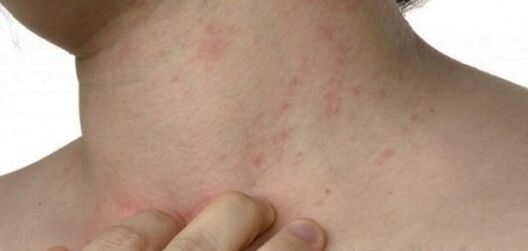
Symptoms of the initial stage of the disease
To recognize the initial stage of the disease, it is important to know what primary symptoms look like.At the very beginning, single papules appear, which can be from several mm to 2-5 cm and have the shape of plaques covered with white scales.When they were scraved, a characteristic symptom of the psoriatic triad is manifested:
- "Starine spot" (light compartment of scales during scravation);
- “Terminal film” (exposure of shiny, thin and wet skin after removing the scales);
- Symptoms of “blood dew” (with further removal of the terminal film, small blood drops resembling dew appear on the surface of the skin).
The initial stage of the disease is characterized by the occurrence of psoriatic foci in places, which are most often subjected to trauma of any kind.As a rule, these are elbows, a knee area in places of combs or scratches.These manifestations are called the "symptom of Kebner."At the very beginning, the papular rash spreads linearly, directly at the place of irritation and can exist for a long time without dynamics.These rashes are called "guard."The rash itches greatly and itchs.The initial stage lasts for several weeks.Subsequently, the papules increase and merge into psoriatic plaques, which are able to cover significant areas of the body.Psoriasis can appear anywhere.The most dangerous rashes on the face are, but this form of the initial stage is very rare.
Characteristic places of localization of the disease in the initial stage
The most common rashes are observed:
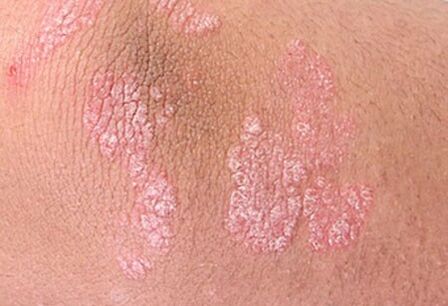
Legs.The initial stage of psoriasis on the legs develops from single small rashes, which are mainly located on the feet and knees, but are able to appear on any surface of the legs.
Elbows.On the elbows, the most common plane occurs, the symptoms of which are characterized by red small rashes with severe peeling.At the same time, coarsening of the skin is observed on the elbows.In addition, rashes on the elbows can be symmetrical.
Nails.On the hands on the nails, psoriatic manifestations resemble a fungal infection.First of all, longitudinal strips (points) occur at the very edge of the nails (in the photo), and then they spread towards the roots of the nails.At the same time, the nail plate begins to thicken and dull.With the progression of symptoms of the disease, the area of the nails can completely exfoliate.
Face.Psoriasis is very rare on the face, since this form of psoriasis is considered atypical.Hypersized papules appear in the area of the eyelids, nasolabial folds, near the eyes and eyebrows (in the photo).In rare cases, the rash on the face appears in the red bachelorous of the lips and mucous membranes (cheeks and tongue).
The specificity of rashes on the face is associated with delicate, sensitive skin and an abundance of nerve endings.First, papules appear (small, slightly raised above the skin, nodules), accompanied by severe itching.Subsequently, an epithelium and plaques appear at the top of the knot.
Hands.Symptoms of psoriasis on the hands occur suddenly, appearing in the form of a small rash (in the photo), which many patients take as an allergic one.And only with the appearance of gray dry scales on their hands, palms, as well as on the elbows, patients turn to a dermatologist for help.It is characteristic that if there is a psoriatic rash on the palms, then similar manifestations are observed on the legs.Psoriatic manifestations on the palms are localized most often between the fingers, which is explained by the most favorable environment in this place.The back parts of the brushes are amazed much less often.When psoriatic spots appear at the fingertips, a loss of their sensitivity is possible.
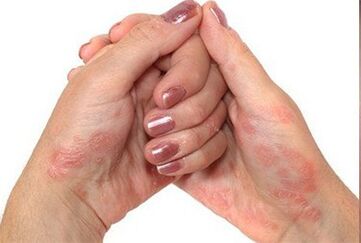
Psoriasis photo of the initial stage
- Deciphering the tests online - urine, blood, general and biochemical.
- What do bacteria and inclusions mean in the analysis of urine?
- How to understand the analyzes of a child?
- Features of an MRI analysis
- Special tests, ECG and ultrasound
- The norms during pregnancy and the values of deviations ..
What is it?Psoriasis is a disease of the skin of a non -infectious nature, so it is impossible to become infected.It affects not only the skin, but also has a negative effect on the whole organism as a whole.It is characterized by a chronic course with periods of exacerbations and remissions.The disease is caused by the immune cells of their own body, that is, it is an autoimmune disease.Rising from the depths of the skin to the upper layers, these cells provoke inflammation, the excessive division of the epidermis cells, leading to excessive growth, the appearance of new small capillaries.Outwardly, it looks like the formation of red or crimson spots - psoriatic plaques.
The first signs and symptoms of psoriasis
Since psoriasis - a systemic disease that affects all systems of the body - the patient suffers from general weakness, rapid fatigue.The main symptom of the initial stage of psoriasis is psoriatic rashes and plaques, however, it accompanies a person with the further development of the disease.They arise due to accelerated uncontrolled division of cells located in the upper layer of the skin-keratinocytes.Involved cells are formed, and the skin in these areas thickens, acquires red because of the enhanced formation of new capillaries.This leads to minor drip bleeding for any, even light, injury to plaques.The surface of the plaques is often covered with a gray raid, similar to paraffin.Even the term "paraffin lakes" was formed.This plaque consists of dead epithelium cells that accumulate on the surface of plaques due to impaired rejection process.Spots can reach quite large sizes, merge with each other.They are hot to the touch, often accompanied by severe itching.Combs can lead to infection.
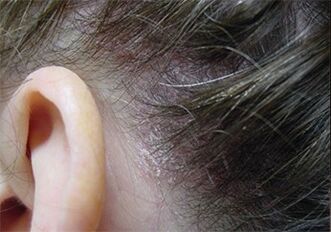
Over time, nails begin to change.Their surface becomes exhausted, pressedness appears, pink spots are noticeable under the nail plate - the accumulation of fluid, the nail turns yellow, thickens, takes the form of poultry claws.All this occurs due to a violation of the nutrition of nails and blood circulation.The nail bed is subjected to excessive keratinization, which leads to the rejection of the nail and loss.Often there is a red inflamed border around the nails.Small joints are affected by illness and small joints - this is accompanied by pain and inflammation.In addition to plaques, with psoriasis, papules form on the skin - small (about 1 mm) protruding formation resembling a rash.Often localized on elbows and knees, preserved even during the period of remission.During improvement, plaques begin to light from the middle, acquire the shape of rings and can completely disappear.Pigmented areas remain in their place.Psoriasis on the scalp has the same symptoms as on the body.In this case, the hair structure does not change.The rashes also cover the adjacent areas of the skin - behind the ears, around the neck.
Types of psoriasis
According to the manifesting symptoms, the disease is divided into two types: pustular and non -labeled.There are several varieties of the disease inside these groups.
Forms of pustular psoriasis:
- generalized;
- Annular;
- palmoplantar (affecting mainly limbs);
- Ladomary;
- Psoriatic impetigo.
- ordinary (chronic plaque psoriasis);
- erythrodermic.
In addition, the following types of the disease are distinguished:
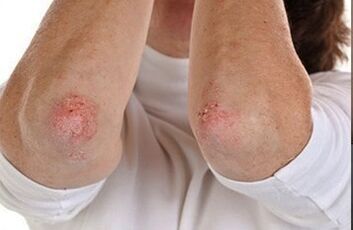
- Psoriasis of Napkin;
- psoriasis of skin folds and flexion surfaces;
- seborrheic -like;
- drug.
- light (affected by less than 3 % of the surface of the body);
- average (affected up to 10 % of the body surface);
- heavy (more than 10 % of surfaces are affected).
Depending on the form of rashes, such types of psoriasis are distinguished:
Stages of development of psoriasis, symptoms
The first plaques appear in areas with the dry skin and never happen where the skin is too wet, for example, armpits.First, the appearance of spots can be seen on the inside of the elbows, under the knees, along the border of the hair on the head, as well as in places subjected to any injury or friction.The location is usually symmetrical.Take such stages during the disease:
- progressive (the formation of new spots, the growth of existing, itching, noticeable peeling);
- stationary (slowdown or suspension of growth of plaques, the absence of newly formed spots);
- Regressive (decrease or lack of peeling, disappearance of stains and plaques with the appearance of pigmented skin areas in their place, signs of psoriasis are almost absent).
There are no special tests to establish a diagnosis.The diagnosis is made on the basis of external characteristic features.One of these signs will be the occurrence of bleeding during the scraping of plaques, the so -called bloody dew.Another specific sign of psoriasis will be the presence of a pale border around a young papule, not yet covered with scales.This is what the vascular reaction of the skin looks, which means the progression of the disease.In severe forms of the disease, a blood picture may change.Signs of the flowing inflammatory process appear.In some cases, you have to do a biopsy to exclude other skin diseases and confirm the presence of psoriasis.
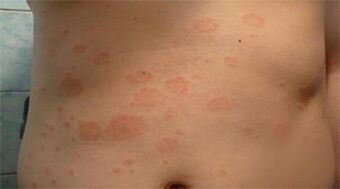
Effective treatment of psoriasis
In the treatment of psoriasis, both local remedies and internal, physiotherapy, and spa treatment are used.In the initial mild course of the disease, drugs in the form of ointments are used.First, ointments and creams of simple composition are used, then go to ointments containing hormones.Cream from psoriasis should be applied only to plaques and spots.With the average and severe course of the disease, internal products that affect the entire body, but give the best results, are used.This group includes vitamin A, immunosuppressants, cytostatics.Physiotherapists bring tangible relief to patients with psoriasis, can inhibit the development of the disease and sometimes replace the use of some drugs.UV irradiation (phototherapy), laser, ultrasound and magnetotherapy, hyperthermia, electrons, electrophoresis, electrophoresis are used.Psoriasis is capable of gaining resistance to used treatment over time, therefore it is recommended to change methods (rotation of treatment) from time to time.The disease with manifestations on the head is treated in the same way as in other parts of the body using ointments and physiotherapy.
Diet with psoriasis
Nutrition should help adjust the metabolism and prevent the appearance or exacerbation of skin symptoms.Since almost all patients have a violation of lipid metabolism, preference should be given to low -fat products.Special diets of fire, Pegano gained wide fame.When compiling a diet, you need to try to comply with some simple rules:
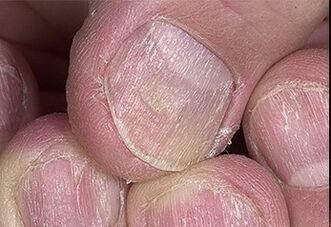
- Rejection of alcoholic beverages;
- Food up to 6 times a day, little by little;
- Exclude fried, smoked food from the diet;
- Reduce salt content in food;
- If possible, do not consume foods with the content of dyes, stabilizers and other nutritional supplements;
- Exclude citrus fruits;
- Increase the share of vegetables and cereals in the diet;
- Mandatory use of vegetable oils.
Compliance with these simple rules will help to avoid exacerbation of psoriasis and independently compose a therapeutic diet.
Psoriasis initial stage symptoms photo
Among the main first symptoms of psoriasis of the initial stage, the appearance of small papular elements of an epidermal-dermal nature is distinguished.At the early stage of psoriasis, in the photo, the papules look small, with a pinkal head, hemispherical formations of pink color with a smooth, shiny surface.A few days later, they are covered with silver-white, lightly scales.Such manifestations are called "point" psoriasis.Psoriasis at an early stage is characterized by the appearance of new small elements of psoriasis or the growth of the already existing first signs of psoriasis.
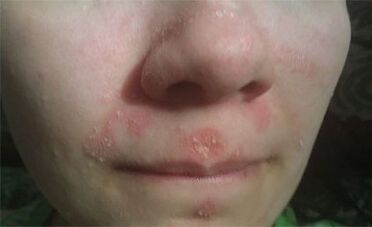
Almost the presence of Kebner’s phenomenon is installed according to linear psoriatic elements that appear after any injury, for example, after combing with severe itching, etc. Finally, with a progressive stage, patients feel itching of various intensity, which is usually not characteristic of other stages of the process.The duration of the progressive stage is individual.Usually the progressive stage lasts from 2 weeks to several months.It is during this period that it is best to use non -hormonal ointments from psoriasis as a prevention and further treatment.
The regressive stage of psoriasis is the final stage of the psoriatic cycle.It is accompanied by a decrease in peeling, gradual flattening of elements in the center and their subsequent complete resolution.In this case, a picture of various figures (arcs, trapezoids, rings) can be obtained.In this case, psoriasis is called "geographical."There may be another way of resolving the elements in which it begins with the periphery of the element.No scars or atrophy are formed.Hyperpigmentations or areas that are devoid of pigment (psoriatic pseudo -proderm) may appear at the site of the permitted elements.These changes are temporary.It should be noted that such a division is largely conditional.In some cases, it is difficult to immediately establish the stage of the process.In this case, the diagnosis of psoriasis is established after observing the patient.























